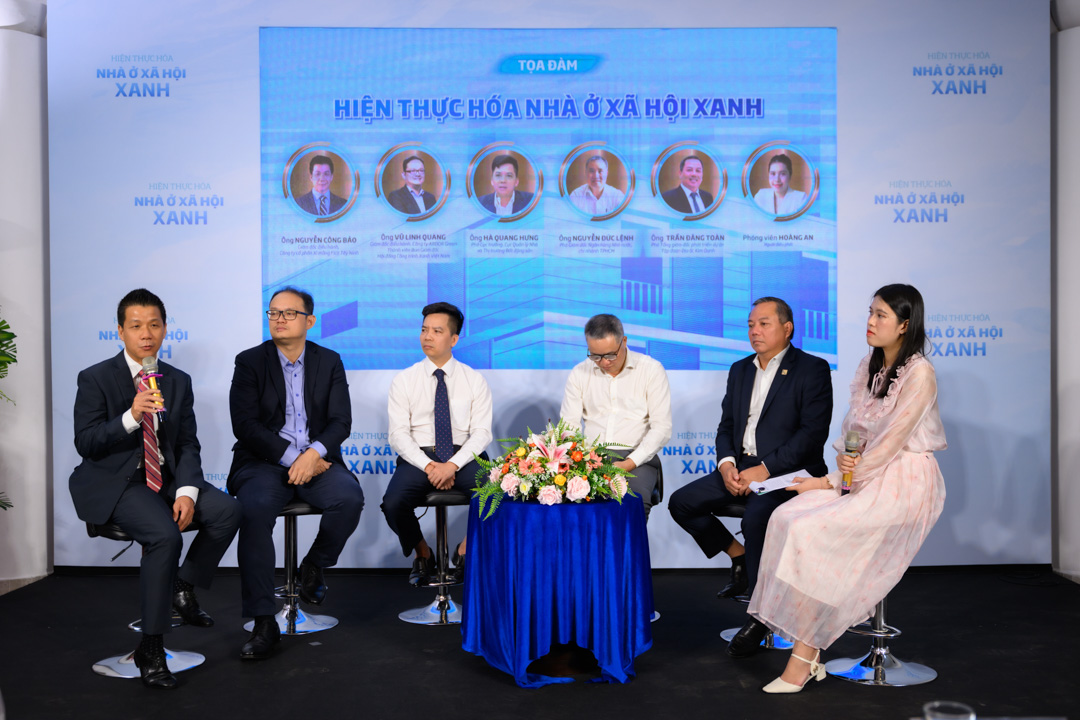Social housing development in Vietnam has faced a myriad of obstacles, and the introduction of green standards has raised concerns about cost. Despite these challenges, Vietnam’s ambitious one-million-social-home program has made certain progress, with 15% of its target already met.
At a seminar held in HCMC on August 22 by the Saigon Times Group in coordination with Fico-YTL, experts said that incorporating sustainability into social housing projects is achievable thanks to Vietnamese construction companies’ extensive experience in developing eco-friendly buildings and producing green-certified cement products.
Benefits of green construction
It might have taken many at the seminar by surprise that green building standards were embraced in Vietnam quite early.
Established in 2007, the Vietnam Green Building Council (VGBC) was founded to raise awareness and capacity for constructing green-standard buildings in Vietnam. By 2010, the VGBC had developed a set of voluntary green building criteria specifically for the Vietnamese construction market. By 2015, various green building standards had been adopted in Vietnam, with adherence primarily depending on the commitments of individual residential project developers.
As of the second quarter of 2024, Vietnam had seen a significant increase in green building adoption, with nearly 11.5 million square meters of certified green buildings in 476 projects, according to Vu Linh Quang, managing director of ARDOR Architect. The most popular certification systems in Vietnam are EDGE with an adoption rate of 44%, LEED with 37%, and Green Mark with 11%.
Each certification system has multiple levels, such as the four levels of EDGE, each with specific requirements. “Depending on the function and scale of the building, costs may increase by 1-3%, or sometimes 5-6%, when applying the higher-level standards of LEED,” Quang said. He added that these costs could gradually decrease due to advancements in technology, design, construction, and the integration of green spaces and living areas within buildings.
Green buildings certainly require a higher upfront investment, but the long-term benefits are substantial for both investors and users. Beyond cost savings in construction and operation, these structures conserve water and energy, reduce noise pollution, and shorten project payback periods. Moreover, green buildings have been shown to reduce symptoms of minor illnesses by 47% due to improved indoor air quality and boost productivity by 17% compared to conventional buildings. This enables green buildings to provide an additional week of 42.75 hours of high-performance working for businesses.
Introducing the first green-labeled cement
In 1824, Joseph Aspdin, a mason from southern England, invented gray cement, which he named Portland cement after the Isle of Portland, his native home. This cement, resembling the limestone found on the island, has become the world’s most widely used building material, essentially for concrete, mortar and grout.
Since the establishment of the first cement plant in Haiphong City by the French in 1899, Vietnam has grown to be the world’s third-largest cement producer, after China and India, and the leading exporter globally.
Portland cement is mainly composed of clinker (95-96%) and gypsum. Cement production is energy-intensive, requiring high heat for the calcination of limestone, leading to significant greenhouse gas emissions and high water usage during construction. The Vietnam National Cement Association (VNCA) has highlighted overcapacity, outdated technology, and high emissions as the industry’s key challenges.
In July 2024, FiCO Cement Joint Stock Company Tay Ninh (Fico-YTL), a member of YTL Group, became the first Vietnamese cement company to voluntarily label its entire product line as eco-friendly under the ECOCem brand. CEO Nguyen Cong Bao attributed this achievement to Fico’s over-five-year commitment to sustainable, environmentally friendly production. Fico products not only meet Vietnam’s National Standards (TCVN) but also adhere to the American Society for Testing and Materials (ASTM) standards. The company’s cement products have received the highest certification from the Singapore Green Building Council (SGBC). Fico’s green-labeled cement contains just 53.6% clinker, significantly lower than the Vietnamese Government’s targets of 65% by 2030 and 60% by 2050.
The raw materials for this green-labeled cement come from blast furnace slag, a byproduct of steelmaking, and fly ash from thermal power plants. Fico-YTL’s eco-cement generates between 350-600kg of CO2 per ton, a reduction of 30-70% compared to conventional Portland cement.
Bao explained that Fico-YTL independently declared its green label in compliance with ISO 14021, a standard system adopted by its parent company YTL in Malaysia, and verified through an internal audit. Fico-YTL takes full responsibility for the claims on the label.
“Although it is still in the early stages for our green cement, we see vast market potential. Green-labeled cement aligns with global sustainability goals and can help reduce emissions significantly without major extra costs,” Bao told The Saigon Times.
According to Bao, Vietnamese companies can achieve green labeling through SGBC certification or by obtaining an Environmental Product Declaration (EPD) from an independent third-party certification body in line with ISO 14025:2006.
Aligning goals with interest rate policy
In April 2023, the Vietnamese Government approved an ambitious plan to build at least one million social homes for low-income people and factory workers between 2021 and 2030. Data from 61 of the country’s 63 provinces and centrally-governed cities showed that since 2021 there have been 619 social housing projects getting underway with a total of nearly 562,000 units, said Ha Quang Hung, deputy director of the Department of Housing and Real Estate Market Management under the Ministry of Construction. Of these projects, 79 have been finished, with 40,600 units, and 128 have got off the ground, with around 112,000 units. In addition, many other projects have been approved for implementation with 410,000 units.
The Government aims to get 428,000 social homes completed by 2025 and an additional 634,000 by 2030, surpassing the initial goal by 10%.
To support this initiative, the State Bank of Vietnam has rolled out a VND120-trillion credit package for developers and buyers of social homes. Borrowers will enjoy interest rates that are 1.5-2 percentage points lower than the long-term rates of the four major commercial banks: Agribank, BIDV, Vietcombank and VietinBank.
The preferential interest rate for social housing loans, which had been set at 4.8% per annum since 2015, has recently changed. Effective August 1, 2024, this rate now aligns with the production loan rates for poor and near-poor households. “Social housing loans are essentially consumer loans, not business ones,” said Hung. “Offering a preferential interest rate of 6.6% per annum, typically reserved for poor and near-poor households, shows the Government’s strong support for low-income individuals.”

However, the interest rate hike is making it harder for low-income people to afford homes. The HCMC Real Estate Association (HoREA) has proposed maintaining the interest rate for social housing loans at the previous level of 3-4.8%. HoREA cited an example of a couple borrowing VND800 million for a VND1-billion home over 20 years. With the new 6.6% interest rate, their monthly payments would increase by VND1.18 million. They argued that a uniform approach to interest rates for urban social housing recipients and rural poor households is unfair, as their financial situations differ significantly.
Currently, the disbursement rate of the credit package is low, with only VND1,344 billion, or 0.96%, disbursed. From 2021 to June 2024, HCMC completed four projects, including three social housing projects and a worker accommodation project, totaling 1,233 units. Out of six social housing projects in HCMC, only three have secured loans amounting to VND170 billion, according to Nguyen Duc Lenh, deputy director of the State Bank of Vietnam’s HCMC branch.
Lenh emphasized the importance of maintaining low interest rates and extended loan terms to support the development of social housing. He stressed the need to balance the goal of constructing one million social housing units with appropriate interest rate policies and credit packages. “Given the growing interest in sustainable living, green social housing has become an essential component of housing development efforts,” Lenh said.
(*) The workshop, titled “Bringing Green Social Homes Into Reality,” was held in HCMC on August 22 by the Saigon Times Group in coordination with Fico-YTL.









